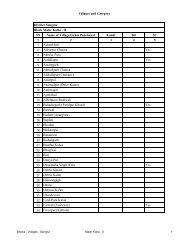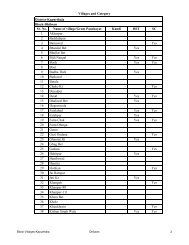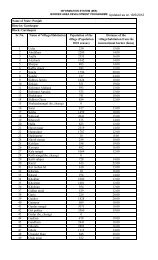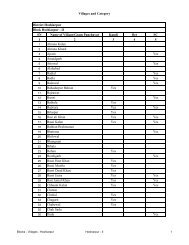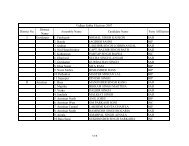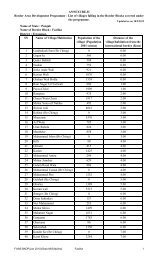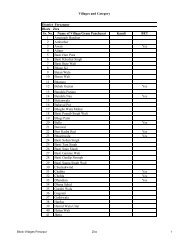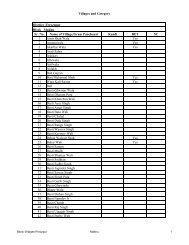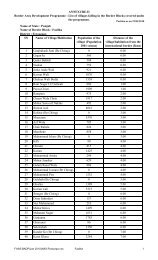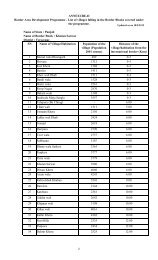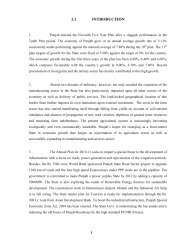X - Punjab State Planning Board
X - Punjab State Planning Board
X - Punjab State Planning Board
Create successful ePaper yourself
Turn your PDF publications into a flip-book with our unique Google optimized e-Paper software.
To<br />
Government of <strong>Punjab</strong><br />
Department of <strong>Planning</strong><br />
(Local Plan Division)<br />
All the Deputy Commissioners in the <strong>State</strong>.<br />
Memo No. 2/1/PSPB-LPD-II/2006/9583<br />
Dated Chandigarh the 5 th July,2006.<br />
Subject:- Guidelines regarding Constitution of District <strong>Planning</strong><br />
Committees in each district of the <strong>State</strong> as per 74 th Constitutional<br />
Amendment, 1992.<br />
Kindly refer to the subject cited above.<br />
2. As per the <strong>Punjab</strong> District <strong>Planning</strong> Committees Act, 2005 (copy<br />
enclosed) issued vide Notification No. 35-LEG/2005, dated 28.11.05, the District<br />
<strong>Planning</strong> Committees are to be constituted in each district of the <strong>State</strong>. The total<br />
number of members of the said committee have been calculated on the basis of<br />
population criteria given in sub-section (2) of Section 3 of the said Act, the detail of<br />
which is given below:-<br />
District wise detail of members to be elected/nominated in the District <strong>Planning</strong> Committees.<br />
4/5 th S.N Name of the Total number of total members to be elected 1/5<br />
District of members Members to be Members to be Total<br />
(Elected + elected from the elected from the Elected<br />
Nominated) Zila Parishad Urban Local<br />
members Bodies<br />
th of total<br />
members to<br />
be nominated<br />
by the <strong>State</strong><br />
Govt.<br />
1 Fatehgarh Sahib 15 9 3 12 3<br />
2 Faridkot 15 8 4 12 3<br />
3 Nawnshehar 15 10 2 12 3<br />
4 Mansa 15 10 2 12 3<br />
5 Kapurthala 15 8 4 12 3<br />
6 Mukatsar 15 9 3 12 3<br />
7 Moga 15 10 2 12 3<br />
8 Ropar 15 9 3 12 3<br />
9 Bathinda 24 13 6 19 5<br />
10 Hoshiarpur 24 15 4 19 5<br />
11 Ferozepur 24 14 5 19 5<br />
12 Patiala 24 12 7 19 5<br />
13 Jalandhar 24 10 9 19 5<br />
14 Sangrur 40 23 9 32 8<br />
15 Gurdaspur 40 24 8 32 8<br />
16 Ludhiana 40 14 18 32 8<br />
17 Amritsar 40 16 16 32 8<br />
18 Mohali 15 7 5 12 3<br />
19 Tarn Taran 15 10 2 12 3<br />
3. The 1/5 th number of members are to be nominated by the <strong>State</strong><br />
Government. For the 4/5 th of the member which are to be elected from amongst the<br />
Zila Parishad members and from members of the urban local bodies, you are<br />
requested to hold the elections in your district as per procedure given below and<br />
send the list of elected members to the <strong>Planning</strong> Department within 15 days so<br />
that the District <strong>Planning</strong> Committees may be constituted by the <strong>State</strong> Government<br />
at the earliest possible:-<br />
- 1 -
3.1 For election of the members from rural areas, the Electoral College would<br />
consist of directly elected members of Zila Parishad. For election of<br />
members from urban areas, Electoral College would consist of directly<br />
elected members/ Councilors of Municipal Corporations/ Municipal<br />
Councils/Nagar Panchayats.<br />
3.2 The Deputy Commissioner or any other officer appointed by him not below<br />
the rank of an Extra Assistant Commissioner would call a meeting of all the<br />
directly elected Zila Parishad members and a separate meeting of all<br />
directly elected members of the Urban Local Bodies (Municipal<br />
Corporations/Municipal Councils/Nagar Panchayats) for election of<br />
members to be taken on the District <strong>Planning</strong> Committees, from amongst<br />
them, after giving 7 days notice indicating therein the total number of<br />
members to be elected and time schedule for holding elections, as per<br />
specimen given in Form 3.2.<br />
3.3 2/3rd of the total directly elected members would constitute a quorum for<br />
conducting the meeting for election.<br />
3.4 When the members assemble at the time and place intimated to them as per<br />
time schedule given in Form 3.2, the Presiding Officer will supply them<br />
nomination form, (as per specimen given in Form 3.4) who may be willing<br />
to contest election for being members of the DPCs. The members would fill<br />
this form and hand it over to the Presiding Officer by the specified time.<br />
3.5 The Presiding Officer will then conduct scrutiny of the nomination forms to<br />
ensure that the same are in order and as per electoral college<br />
3.6 Any member may withdraw his candidature by filling Form 3.6 which will<br />
be handed over by him to the Presiding Officer by the time specified in Form<br />
3.2.<br />
3.7 Immediately after the said process, the Presiding Officer will prepare the<br />
final list of contesting candidates and get it printed on the Column 2 of the<br />
ballot paper (specimen in Form 3.7).<br />
3.8 If the total number of contesting candidates is less than or equal to the<br />
number of vacancies to be filled, there will be no election and all such<br />
members will be declared to be duly elected.<br />
3.9 If the number of contesting candidates is the more than the vacancies to be<br />
filled, the Presiding Officer would supply them a ballot paper (as per<br />
specimen in Form 3.7) which will be serial numbered and ask them to mark (<br />
) against the name of the person to whom he wants to elect and mark (X) to<br />
whom he does not want to elect. The ballot paper should be filled up by<br />
Presiding Officer except column No.3 against names of contesting<br />
candidates. At the time of issuing a ballot paper to a voter, the Presiding<br />
Officer will sign in full on the ballot paper, record the serial number thereof<br />
in the counterfoil of the ballot paper, put the official seal and also mark the<br />
name of the voter in the voter list.<br />
3.10 After receiving the ballot paper, the voter would mark the necessary signs (<br />
) or (X) on the ballot paper, fold it and insert in it into the ballot box.<br />
- 2 -
3.11 On the same day and at the time as per time schedule given in Form 3.2, the<br />
Presiding Officer will open the ballot box and count the number of ballot<br />
papers taken out there from.<br />
3.12 The Presiding Officer will reject a ballot paper if it bears any mark or writing<br />
by which the voter can be identified; or if no vote is recorded thereon; or if<br />
voter is in favour of candidates more than the vacancies to be filled or if the<br />
mark indicated thereon is placed in such a manner as to make it doubtful<br />
to which candidates the vote has been given; or if it is spurious ballot paper;<br />
or if it does not bear both the official seal and the signature of the Presiding<br />
Officer.<br />
3.13 After completion of counting, the Presiding Officer will record in a<br />
statement, the total number of votes polled by each candidate and announce<br />
the result.<br />
3.14 If quorum of the meeting is not fulfilled and the meeting is adjourned,<br />
another meeting will be convened by the Presiding Officer by giving not<br />
less than 24 hours notice to the members. No quorum will be necessary for<br />
the adjourned meeting.<br />
3.15 If, at the bottom, two or more members get the same number of votes, the<br />
matter will be decided by draw of lots.<br />
3.16 The Deputy Commissioner would keep in safe custody all papers relating to<br />
the elections. However, on the expiry of six months from the date of<br />
publication of the names of the elected members of the District <strong>Planning</strong><br />
Committee, all the papers relating to the election may be destroyed.<br />
3.17 If any vacancy arises due to any reason, it will be filled up with the same<br />
procedure from the same source from which it has occurred.<br />
3.18 If the total number of directly elected Zila Parishad/Urban Local<br />
Bodies members, as the case may be, is less than or equal to the number of<br />
vacancies to be filled, there will be no election and such members will be<br />
declared to be duly elected.<br />
3.19 The Deputy Commissioner will send the list of elected candidates to the<br />
<strong>State</strong> <strong>Planning</strong> Department on the same day both by speed post as well as by<br />
Fax.<br />
- 3 -<br />
(R.L.Mehta)<br />
Special Secretary <strong>Planning</strong><br />
Endst.No.2/1/PSPB-LPD-II/2006/ Dated 5th July, 2006.<br />
A copy is forwarded to the following:-<br />
i) Private Secretaries of Ministers/ Ministers of <strong>State</strong> for the kind<br />
information of Hon’ble Ministers/ Ministers of <strong>State</strong>. PSCM<br />
ii) Special Secretary/ FM for the kind information of Hon’ble Finance and<br />
<strong>Planning</strong> Minister, <strong>Punjab</strong>.<br />
iii) Secretary/CS for the kind information of Chief Secretary, <strong>Punjab</strong>.<br />
Special Secretary <strong>Planning</strong>.
Regd.No.PB/0061/2003-05 Regd.No.NW/CII-22<br />
PUNJAB GOVERNMENT GAZETTE<br />
EXTRAORDINARY<br />
Published by Authority<br />
CHANDIGARH, MONDAY, NOVEMBER 28, 2005<br />
(AGRAHAYANA 7, 1927 SAKA)<br />
LEGISLATIVE SUPPLEMENT<br />
Part I Acts<br />
Contents Pages<br />
The <strong>Punjab</strong> District <strong>Planning</strong> Committees<br />
Act,2005<br />
Part II Ordinances<br />
(<strong>Punjab</strong> Act No. 22 of 2005) 213-217<br />
Nil<br />
Part III Delegated Legislation<br />
Nil<br />
Part IV Correction Slips, Republications and<br />
Price: Rs. 2.70 Paise<br />
Replacements<br />
Nil<br />
- 4 -
PUNJAB GOVT.GAZ(EXTRA.) NOVEMBER 28, 2005 213<br />
(AGHN.7,1927 SAKA)<br />
PART I<br />
DEPARTMENT OF LEGAL AND LEGISLATIVE AFFAIRS, PUNJAB<br />
Notification<br />
The 28 th November, 2005<br />
No.35-Leg./2005.- The following Act of the Legislature of the <strong>State</strong> of<br />
<strong>Punjab</strong> received the assent of the Governor of <strong>Punjab</strong> on the 22 nd November, 2005<br />
and is hereby published for general information:-<br />
THE PUNJAB DISTRICT PLANNING COMMITTEES ACT, 2005<br />
(<strong>Punjab</strong> Act No.22 of 2005)<br />
An Act to provide for the constitution of the District <strong>Planning</strong> Committees<br />
with a view to consolidate the plans prepared by the Panchayats and the<br />
Municipalities in the districts and to prepare the draft development plans for the<br />
districts as a whole in the <strong>State</strong> and for the matters connected therewith and<br />
incidental thereto.<br />
Be it enacted by the Legislature of the <strong>State</strong> of <strong>Punjab</strong> in the Fiftysixth<br />
Year of the Republic of India.<br />
1.(I)This Act may be called the <strong>Punjab</strong> District <strong>Planning</strong><br />
Short title and<br />
Committees Act, 2005.<br />
Commencement<br />
(2) It shall come into force at once.<br />
2. In this Act, unless the context otherwise requires- Definitions<br />
(a) “Chairperson”means the Chairperson of the Commiittee<br />
chosen under sub-section (3) of section 3;<br />
(b) “Committee” means the District <strong>Planning</strong> Committee<br />
Constituted under sub-section (1) of section 3;<br />
(c) “district” means a revenue district in the <strong>State</strong>;<br />
(d) “member” means a member of the Committee and includes<br />
its Chairperson;<br />
(e) “Municipality” shall have the same meaning as assigned to<br />
it under clause (e) of Article 243-P of the Constitution of India;<br />
(f) “Panchayat” shall have the same meaning as assigned to it<br />
under clause (f) of Article 243-P of the Constitution of India;<br />
(g) “population”means the population as ascertained at the last<br />
preceding census of which the relevant figures have been<br />
published;<br />
(h) “prescribed” means prescribed by rules made under this Act;<br />
(i) “section” means section of this Act;<br />
(j) “<strong>State</strong>” means the <strong>State</strong> of <strong>Punjab</strong>; and<br />
(k) “<strong>State</strong> Government” means the Government of the <strong>State</strong> of<br />
<strong>Punjab</strong><br />
- 5 -
Constitution<br />
of District<br />
<strong>Planning</strong><br />
Committee.<br />
Term of<br />
members of<br />
the<br />
Committee<br />
PUNJAB GOVT.GAZ(EXTRA.) NOVEMBER 28, 2005 214<br />
(AGHN.7,1927 SAKA)<br />
3. (1) There shall be constituted a Committee to be called the District <strong>Planning</strong><br />
Committee by the <strong>State</strong> Government for every district in the <strong>State</strong> to<br />
consolidate the plans prepared by the Panchayats and the Municipalities in<br />
the district and to prepare a draft development plan for the district as a<br />
whole.<br />
(2) The number of members of a District <strong>Planning</strong> Committee constituted under<br />
sub-section (1), shall be calculated as per population of the district concerned<br />
according to the following criteria, namely:-<br />
(a) District having population, Fifteen members<br />
Not exceeding ten lacs;<br />
(b) Districts having population Twenty four members<br />
exceeding ten lacs, but not exceeding twenty lacs; and<br />
(c) Districts having population Forty Members<br />
exceeding twenty lacs.<br />
(3) The Chairperson of the Committee shall be chosen from amongst<br />
the members of the Committee by the <strong>State</strong> Government by nomination.<br />
(4) The seats of the members of the Committee shall be filled by election, from<br />
amongst the elected members of the Panchayat at the district level and of the<br />
Municipalities in the district, and by nomination.<br />
(5) Not less than four-fifths of the total number of members of the Committee<br />
shall be elected by, and from amongst the elected members of the Panchayat<br />
at the district level and of the Municipalities in the district in proportion to<br />
the ratio between the population of the rural areas and of the urban areas in<br />
the district.<br />
(6) One- fifth of the total number of members of the Committee, which may<br />
include the Members of the Legislative Assembly and other persons also,<br />
shall be nominated by the <strong>State</strong> Government.<br />
(7) The Deputy Commissioner of the district shall be the ex-officio Secretary of<br />
the Committee.<br />
(8) The Additional Deputy Commissioner (Development) of the district shall be<br />
the ex-officio Additional Secretary of the Committee.<br />
(9) The Deputy Economic & Statistical Adviser of the District shall be the exofficio<br />
Joint Secretary of the Committee.<br />
4 (1) The term of an elected member of Committee shall be co-terminus with the<br />
term of the Panchayat at the district level or a Municipality, as the case may<br />
be , of which he is a member.<br />
(2) The term of a nominated member including the Chairperson, shall be one<br />
year. However, a nominated member shall be eligible for re- nomination<br />
after the expiry of his first term.<br />
- 6 -
Abolition of<br />
DP & DB.<br />
Meetings<br />
Functions<br />
of the<br />
Committee<br />
PUNJAB GOVT.GAZ(EXTRA.) NOVEMBER 28, 2005 215<br />
(AGHN.7,1927 SAKA)<br />
(3) Any member of the Committee including the Chariperson, may resign at any<br />
time from his office before his tenure.<br />
5. (1) Subject to the provisions of this Act, the Committee shall exercise powers<br />
and perform the functions as mentioned below:-<br />
a) to prepare the draft district development plan keeping in view the<br />
matters of common interest between urban and rural population<br />
including spatial planning sharing of water and other physical and<br />
natural resources, the integrated development of infrastructure and<br />
environment conservation, the plans prepared at the grass-root level by<br />
the concerned Panchayat and the extent and type of available resources<br />
whether financial or otherwise;<br />
b) to prepare priority-wise list of schemes and programmes taking into<br />
account the resources available with the Committee and the resources<br />
provided by the <strong>State</strong> Government.<br />
c) to take appropriate measures for proper implementation of the<br />
development schemes, programmes and projects;<br />
d) to monitor the progress of projects;<br />
e) to encourage the Panchayats and the Municipalities to take up and<br />
expedite the implementation of development projects;<br />
f) to make efforts to generate additional resources for development works<br />
with the cooperation of people; Non-Government Organizations and<br />
Non-Resident Indians and other agencies; and<br />
g) to perform such other additional functions relating to District <strong>Planning</strong><br />
and Coordination and monitoring of the activities of different<br />
departments of the <strong>State</strong> Government, as may be assigned to the<br />
Committee by the <strong>State</strong> Government.<br />
(2) While preparing the draft development plan, the Committee may consult such<br />
institutions and organisations, as may be specified by the <strong>State</strong> Government<br />
from time to time.<br />
(3) The Chairperson shall forward the district development plans prepared by<br />
the Committee under clause (a) of sub-section (1) to the <strong>State</strong> Government.<br />
6. With effect from the date, the Committees are constituted under this Act, the<br />
existing District <strong>Planning</strong> and Development <strong>Board</strong>s in the <strong>State</strong> shall cease to<br />
function.<br />
7. (1) In the transaction of its business, the Committee shall follow such procedure,<br />
as may be prescribed.<br />
(2) If on account of any reason, the Chairperson is unable to attend the meeting of<br />
the Committee, any other member, chosen by the present members, shall<br />
preside over the meeting.<br />
(3) The meeting of the Committee shall be held at the District Head Quarters or at<br />
such place, as may be decided by the Committee.<br />
- 7 -
Removal and<br />
suspension of<br />
members<br />
including<br />
Chairperson<br />
Filling of<br />
vacancies<br />
Power to<br />
issue<br />
directions<br />
Power to<br />
make rules<br />
PUNJAB GOVT.GAZ(EXTRA.) NOVEMBER 28, 2005 216<br />
(AGHN.7,1927 SAKA)<br />
8. The <strong>State</strong> Government may remove the Chairperson or any member from his<br />
office, if:-<br />
a) he has been adjudged insolvent; or<br />
b) he has been convicted of an offence which, in the opinion of the <strong>State</strong><br />
Government, involves moral turpitude; or<br />
c) he has become physically or mentally incapable; or<br />
d) he has acquired such financial or other interest, as is likely to affect<br />
prejudicially his functions in any of the said capacities; or<br />
e) he has so abused his position as to render his continuance in office prejudicial<br />
to the public interest.<br />
(2) Before removing any member including the Chairperson from his office, a<br />
reasonable opportunity of being heard shall be given to him by the <strong>State</strong><br />
Government.<br />
9. If any vacancy occurs, it shall be filled up from the same source from which it has<br />
occurred.<br />
10. The <strong>State</strong> Government may, from time to time, issue such directions to the<br />
Committees, as it may consider appropriate in public interest.<br />
11. (1) The <strong>State</strong> Government may, by notification in the Official Gazette, make rules<br />
for carrying out the purposes of this Act.<br />
(2) Every rule made under this Act, shall be laid, as soon as may be, after it is<br />
made, before the House of the <strong>State</strong> Legislature, while it is in session, for a<br />
total period of ten days, which may be comprised in one session or in two or<br />
more successive sessions, and if, before the expiry of the session in which it is<br />
so laid or the successive sessions as aforesaid, the House agrees in making any<br />
modification in the rule or the house agrees, that the rule should not be made,<br />
the rule shall thereafter have effect only in such modified form or be of no<br />
effect, as the case may be, so however that any such modification or annulment<br />
shall be without prejudice to the validity of anything previously done or<br />
omitted to be done under that rule.<br />
- 8 -
Power to<br />
remove<br />
difficulties<br />
PUNJAB GOVT.GAZ(EXTRA.) NOVEMBER 28, 2005 217<br />
(AGHN.7,1927 SAKA)<br />
12. (1) If any difficulty arises in giving effect to any of the provisions of this Act, the<br />
<strong>State</strong> Government may, by an order published in the Official Gazette, make<br />
such provisions not inconsistent with the provisions of this act, as may appear<br />
to it to be necessary for removing the difficulty.<br />
Provided that no such order shall be made under this section after the expiry of<br />
a period of two years from the date of the commencement of this act.<br />
(2) Every order made under this section, shall be laid, as soon as may be, after it is<br />
made, before the <strong>Punjab</strong> Legislative Assembly.<br />
H.S.BHALLA<br />
Secretary to Government of <strong>Punjab</strong>,<br />
Department of Legal and Legislative Affairs.<br />
7176 LR(P)-Govt Press,UT,Chd<br />
- 9 -
ckow 3H2<br />
(whfNzr d/ B'fN; dk Bw{Bk)<br />
;aqh________________HHHHHHHHHHHHHHHHHHHHHHHHHHHHHHHHHHHHHHHHHHHHHHHH B{z ;{fus ehsk iKdk j? fe fiabQk :'iBkpzdh ew/Nh<br />
d/ HHHHHHHHHHHHHHHHHHHHHHHHHHHH(Bzpo) w?Apo u[DB bJh fiabQk gqh;ad$ fwT{A;g?bNhia (i' th bkr{ j't/)<br />
d/ f;ZX/ s"o s/ u[D/ j'J/ w?ApoK dh ;g?;ab whfNzr fwshHHHHHHHHHHHHHHHHHHHHHHHHHHH B{z<br />
HHHHHHHHHHHHHHHHHHHHHHHHHHHHHHHHHHHHHti/HHHHHHHHHHHHHHHHHHHHHHHHHHHHHirQk s/ j'Dh fB;afus j'Jh j?. whfNzr ftu<br />
Gkr b?D dh y/ub ehsh ikt/.<br />
2H u'D dk gq’'rokw j/m fby/ nB[;ko j't/rkL-<br />
-ft;a/ dk ;zy/g t/otk HHHHHHHHHHHHti/ s'A HHHHHHHHHti/ sZe<br />
-BkwhB/;aB ckow GoBk HHHHHHHHHHHHti/ s'A HHHHHHHHHti/ sZe<br />
-BkwhB/;aB ckowK dh gVskb HHHHHHHHHHHHti/ s'A HHHHHHHHHti/ sZe<br />
-BkwhB/;aB ckow B{z HHHHHHHHHHHHti/ s'A HHHHHHHHHti/ sZe<br />
tkg; b?Dk<br />
-t'fNzr i/ iao{oh j't/ HHHHHHHHHHHHti/ s'A HHHHHHHHHti/ sZe<br />
-t'NK dh frDsh HHHHHHHHHHHHti/ s'A HHHHHHHHHti/ sZe<br />
-Bshi/ dk n?bkB HHHHHHHHHHHHHHHHHHHHHHHHHHHHHHHHHHHHHHti/<br />
gqhikJhfvzr nc;oHHHHHHHHHHHHHHHHHHHHHHHHHHHHHHHH<br />
fwshL Bkw ns/ nj[dkHHHHHHHHHHHHHHHHHHHHHHHHHHHHHHHHH<br />
dcso dh ;hbHHHHHHHHHHHHHHHHHHHHHHHHHHHHHHHH
fibQ/ dk BKHHHHHHHHHHHHHHHHHHHHHHHHHHHHHHHHHHHHHHHHHHHHHHHHHHHHHHHH<br />
ckow 3H4<br />
(BkwhB/;aB ckow dk Bw{Bk)<br />
BkwhB/;aB dk u'D y/so HHHHHHHHHHHHHHHHHHHHHHHHHHHHHHHHHHHHH(fiabQk gqh;ad iK fwT{;ag?bNhia)<br />
1H T[whdtko dk g{ok Bkw HHHHHHHHHHHHHHHHHHHHHHHHHHHHHHHHHHHHHHHHHHHHHHHHHHHHHHHHHHHHHHHHHHHHHHHHHHHH<br />
2H fgsk$gsh dk BK HHHHHHHHHHHHHHHHHHHHHHHHHHHHHHHHHHHHHHHHHHHHHHHHHHHHHHHHHHHHHHHHHHHHHHHHHHH<br />
3H T[wo HHHHHHHHHHHHHHHHHHHHHHHHHHHHHHHHHHHHHHHHHHHHHHHHHHHHHHHHHHHHHHHHHHHHHHHHHH<br />
4H fbzr HHHHHHHHHHHHHHHHHHHHHHHHHHHHHHHHHHHHHHHHHHHHHHHHHHHHHHHHHHHHHHHHHHHHHHHH<br />
s/ u'D bVBk ukj[zdk jK.<br />
w?A fiabQk :'iBkpzdh ew/Nh ftu u[D/ ikD tkb/ w?ApoK bJh T[whdtko d/ s"o<br />
T[whdtko d/ j;skyo<br />
w?A fJj s;dhe eodk jK fe T[go'es BkwhB/;aB ckow, ckow BzLL-. ftu<br />
;{fus ehs/ rJ/ ;w/ AnB[;ko w?B{z gqkgs j' frnk j?.<br />
gqhikJhfvzr nc;oHHHHHHHHHHHHHHHHHHHHHHHHHHHHHHHH<br />
fwshL Bkw ns/ nj[dkHHHHHHHHHHHHHHHHHHHHHHHHHHHHHHHHH<br />
dcso dh ;hbHHHHHHHHHHHHHHHHHHHHHHHHHHHHHHHH
fibQ/ dk BKHHHHHHHHHHHHHHHHHHHHHHHHHHHHHHHHHHHHHHHHHHHHHHHHHHHHHHHH<br />
ckow 3H6<br />
(BkwhB/;aB tkg; b?D d/ ckow dk Bw{Bk)<br />
BkwhB/;aB dk u'D y/soHHHHHHHHHHHHHHHHHHHHHHHHHHHHHHHHHHHHHHHHHHH(fiabQk gqh;ad iK fwT{;ag?bNhia)<br />
1H T[whdtko dk g{ok Bkw HHHHHHHHHHHHHHHHHHHHHHHHHHHHHHHHHHHHHHHHHHHHHHHHHHHHHHHHHHHHHHHHHHHHHHHHHHHH<br />
2H fgsk$gsh dk BK HHHHHHHHHHHHHHHHHHHHHHHHHHHHHHHHHHHHHHHHHHHHHHHHHHHHHHHHHHHHHHHHHHHHHHHHHHH<br />
3H T[wo HHHHHHHHHHHHHHHHHHHHHHHHHHHHHHHHHHHHHHHHHHHHHHHHHHHHHHHHHHHHHHHHHHHHHHHHHH<br />
4H fbzr HHHHHHHHHHHHHHHHHHHHHHHHHHHHHHHHHHHHHHHHHHHHHHHHHHHHHHHHHHHHHHHHHHHHHHHH<br />
w?A fiabQk :'iBkpzdh ew/Nh ftu u[D/ ikD tkb/ w?ApoK bJh T[whdtko d/ s"o<br />
s/ yVk j'D ;pzXh Go/ rJ/ ckow BzL 3H4 B{z tkg; b?Adk jK.<br />
T[whdtko d/ j;skyo<br />
w?A fJj s;dhe eodk jK fe T[go'es BkwhB/;aB tkg; b?D dk ckow, ckow<br />
BzLL 3H2 ftu ;{fus ehs/ rJ/ ;w/ AnB[;ko w?B{z gqkgs j' frnk j?.<br />
gqhikJhfvzr nc;oHHHHHHHHHHHHHHHHHHHHHHHHHHHHHHHH<br />
fwshL Bkw ns/ nj[dkHHHHHHHHHHHHHHHHHHHHHHHHHHHHHHHHHHHH<br />
dcso dh ;hbHHHHHHHHHHHHHHHHHHHHHHHHHHHHHHHHHHHHH
ckow BzL 3H7<br />
(p?bN g/go dk Bw{Bk)<br />
1H fibQ/ dk BKHHHHHHHHHHHHHHHHHHHHHHHHHHHHHHHHHHHHHHHHHHHHHHHHHHHHHHHH<br />
2H u'D y/so (fJb?eN'ob ekbi)HHHHHHHHHHHHHHHHHHHHHHHHHHHHHHHHHHHHHHHHHH(fiabQk gqh;ad iK fwT{;ag?bNhia)<br />
3HH u'D ftu yV/Q j'J/ w?ApoK dh e[b frDshHHHHHHHHHHHHHHHHHHHHHHHHHHHHHHHHHHHHHHHHHHHHHHHHHHHHHHHHHHHHHHHHH<br />
4H T[go'es ftu'A fiabQk :'iBkpzdh ew/NhnK ftu HHHHHHHHHHHHHHHHHHHHHHHHHHHHHHHHHHHHHHHHHHHHHHHHHHHHHHH<br />
w?Apo d/ s”'o s/ oZy/ ikD bJh u[D/ ikD<br />
tkb/ w?ApoK dh frDsh<br />
bVh BzL u'D ftu yVQ/ j'J/ w/?Apo dk BK t'No tb'a u[D/ ikD tkb/ w?Apo<br />
bJh ehsh rJh f;cko;<br />
1 2 3<br />
1 ( )<br />
2 ( )<br />
3 ( )<br />
4 ( )<br />
5 ( )<br />
6 ( )<br />
7 ( )<br />
- ( )<br />
- ( )<br />
- ( )<br />
ubdk ( )<br />
B'NL fi; w?Apo B{z t'No t'N d/Dk ukj[zdk j?, T[; BK ;kjwD/ ( ) ns/ fi; B{z BjhA<br />
d/Dk ukj[zdk, T[; d/ BK ;kjwD/ (X) wkoe eo/rk.<br />
gqhikJhfvzr nc;oHHHHHHHHHHHHHHHHHHHHHHHHHHHHHHHH<br />
fwshL Bkw ns/ nj[dkHHHHHHHHHHHHHHHHHHHHHHHHHHHHHHHHH<br />
dcso dh ;hbHHHHHHHHHHHHHHHHHHHHHHHHHHHHHHHH



